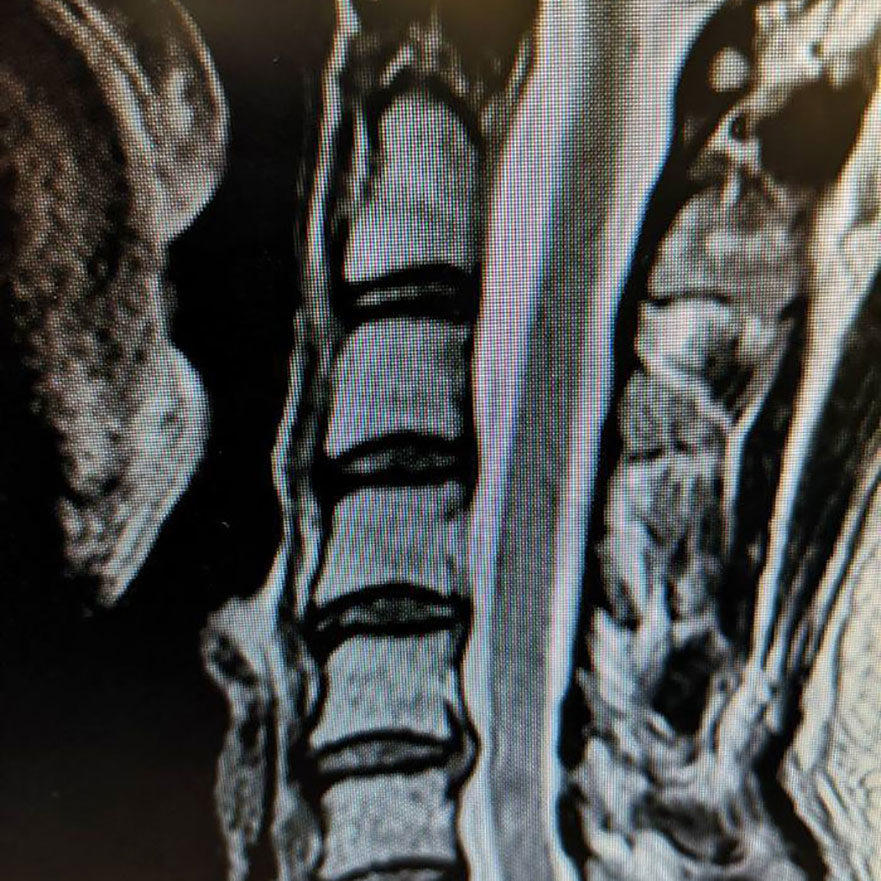
23rd September 2020
Back pain is an common ailment in our increasingly sedentary lives. We drive rather than walk, we sit rather than stand and during these times of covid we spend even more time hunched over screens, often at a desk that has not been set up with back health in mind.
As someone who has suffered chronic back pain since childhood I have every sympathy for people who arrive at my classes with back pain. Recently I have even had doctors referring patients to me for yoga which is a fantastic development.
Before I talk about postures that are helpful to address (and prevent) back pain I will share a little of my own story.
The image below is an MRI of my spine. This was taken when I was in a good phase but you can still see how one of my disks is pressing into the spinal nerves. It doesn’t take much for all that area to become inflamed and result in huge pain. That’s my Lumbar vertebrae where I have the classic L4 and L5 issues and lots of general degeneration of the disks. My consultant told me that my spine is basically looking like someone in their 70s Thanks!). In my cervical spine I have multiple bulging disks and early evidence of spondylitis. I’m generally also very susceptible to inflammation across my body. This means I am very prone to getting injured. The slightest shock to my neck gives me severe whiplash-like injuries as all my soft tissues contract to protect my spine.

How yoga helps a bad back
Despite having spent thousands on different therapies from osteopathy to acupuncture, reiki, physiotherapy and more I have found that the one thing I can do that provides lasting relief from pain (and protection from further injury) is yoga. I’m no longer on pain killers and no longer feel like an old person when I get out of bed in the morning. If I want I can touch my toes within minutes of waking – previously I’d have been hours before even daring to bend over let alone get low enough to touch the floor.
I have to be careful about what type of yoga I do. I need to warm up well to begin a class. A fast physical class such as vinyasa flow has the propensity to cause problems especially if I over stretch or fail to get into position well. I also find that using props such as blocks are helpful to secure optimum alignment.
So what I have developed over the years is a set of postures (asanas or “shapes”) that I use in the majority of my classes and personal practice that act both to loosen up my back as well as mitigate against future injury. These shapes might strengthen the core and psoas muscles, but many also work to stretch the muscles that affect the back such as the hamstrings, glutes and adductors.
Yoga exercises for back pain
Here are some of the postures I find helpful. You’ll find I use all these regularly in my classes. Practice them slowly with deep breathing:
- Release the fascia by rolling the feet over a golf ball. Then put two tennis balls in a sock and roll up and down the spine
- Extended child’s pose
- Cat Cow – on all fours, seated or standing
- Supine table top heel taps
- Two knee spinal twists
- Knee circles
- Wind relieving pose (head to knee) – done on the back one leg at a time
- Thread the Needle
- Downward facing dog moving into a high plank (these poses will also build upper body and core strength)
- Dolphin (like Downward Dog but on the elbows)
- Puppy Dog (like Extended Child but with the hips high)
- Extended Triangle
- Cobra and Sphinx – a lovely back bend that can be as intense as you make it
- Locust – a more intense back bend
- Planks – low, high, on knees and elbows or hands and feet. Start with a standard plank and work up to side planks supported on the knee if needed
- Low or high lunges
- Pigeon – either standard half pigeon or reverse pigeon (figure four pose) – great for stretching out the glutes
- Lizard – do not work through pain if this pose is too much for you though
- Spine hamstring stretches using a yoga strap
- Chair
- Pelvic rocking and Bridge
- Garland (squats with heels on the floor or on blocks)
- Firelog (to open the hips)
- Tiger/Superman poses (for core strengthening)
- Forward Folds (including with wide legs)
- Wide legged squat over one leg (to stretch adductors)
- Half Lord of the Fishes – remember the counter twist too
- Happy Baby
- Bound angle pose (using blocks to support the knees)
- Half moon pose – one for the more experienced yogi – use a block under the hand
- For tight upper backs and shoulders supplement your practice with twists (eg in Lunge and Chair)
- Rather than savasana you can finish your practice with Legs up the Wall pose
Classes for the prevention and treatment of back pain
If these postures all sound rather scary and you have no idea what the all mean then come along to a class and I’ll guide you through them. This autumn my Saturday classes (and some of the midweek ones) will focus on postures for the prevention and treatment of back pain. Book in here.
If you’d like a handout with all these postures shown you can download one here. However I do not recommend you do all these postures without either prior experience of yoga. Try to work through them with a teacher that can guide to in optimum alignment.
What postures to avoid
Depending on the type of back pain you have there are some postures that should be avoided. People with sciatica should generally avoid seated and standing forward bends however for some back issues (mine included) a standing forward bend is a lovely pain relieving posture.
The general rule is not to work through pain. Make sure you warm up well before experimenting with more advanced postures. The ideas at the top of the list are good warm ups.
It is always fine to adapt a posture to suit where you are at on any given day. So if Downward Dog is too much try bending the knees, putting blocks under the hands or simply using an Extended Child instead.
Don’t swing your legs forward in the Sun Salutation sequence or in flows such as Dog to Pigeon if you are likely to agitate a back injury. Move slowly and shift the foot manually with your hand if you need to. There are no prizes for being a hero in a yoga class and going deeper into a posture than you should. Take it easy and build up into postures.
Do also take your time. The fascia and soft tissues take a while to stretch and settle. So, for instance, move into a standing forward fold and wait. Gently and gradually increase the depth of the fold as the soft tissues relax.
How diet helps
Inflammation is a massive issue in back pain. Our soft tissues inflame in order to protect the spine but it is this inflammation that we perceive as pain. Inflammation means we are less likely to move and the less we move, the more we seize up. As well as regular yoga I would also strongly recommend you look at your diet. Completely remove dairy and meat from your diet and eat more plant-based foods – meat and dairy are big inflammatory triggers. Don’t expect an immediate improvement but as the body embraces this new way of eating you should see the benefits. Check out Dr Michael Greger’s Nutrition Facts website for more information. I would also recommend you take a turmeric supplement each day ideally one with black pepper which aids absorption (I like the Better You spray).